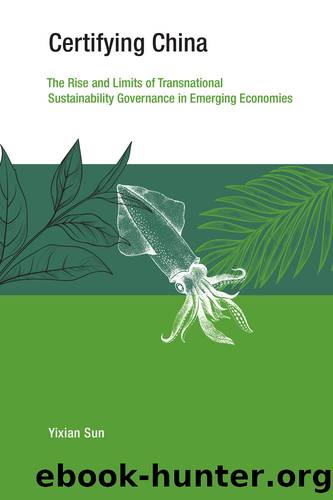Certifying China by Yixian Sun

Author:Yixian Sun
Language: eng
Format: epub
Tags: Transnational governance; sustainability; eco-certification; China; agrifood chains; non-state actors
Publisher: MIT Press
5.1â â â The Rise of Eco-Certification in the Global Tea Market
Located in tropical and subtropical areas, most tea production regions are ecologically sensitive and underdeveloped. The commodity has therefore been associated with several sustainability issues. Biodiversity loss and land-use change are deemed the key environmental challenges, due to the expansion of monoculture plantations at the expense of tropical forests (H. Li et al. 2012; Owuor et al. 2018). Another major concern is the overuse of agrochemicals as pesticides and fertilizers, which have negative effects on both consumersâ health and the local environment. For instance, residues of hazardous pesticides have been found to be higher than the recommended limits in many tea products sold in China and India (Greenpeace 2012, 2016; Greenpeace India 2014). Moreover, labor rights violationsâincluding exploitation, unsafe working conditions, and child laborâare prevalent in tea plantations across developing countries (van der Wal 2008; Wu 2009). Additionally, in the global tea supply chain, the value distribution has been highly uneven between upstream producers and a handful of multinational brands focusing on blending, packing, and marketing, and as a result, Southern producers hardly benefit from market growth and have few resources to improve their practices (Talbot 2002; van der Wal 2008; LeBaron 2018).
Despite the salience of these issues, tea was relatively late in becoming a dynamic field of eco-certification compared to other tropical commodities, such as coffee and cocoa. By the late 2000s, only a small group of stakeholders in the global tea supply chain were aware of corporate social responsibility and sustainability standards (van der Wal 2008). But rapid progress has been made since then with the development of tea standards by large transnational certification programs like Rainforest Alliance (RA). In the past decade, sustainable tea certification has experienced remarkable growth: as of 2017, around 19% of the area on which tea is harvested globally was certified to sustainability standards to supply at least 20.9% of the global production volume (Willer et al. 2019).2 At the time of writing, Fairtrade International, RA, and UTZ are the three major transnational eco-certification programs for tea, whereas organic certification is subject to national regulation in most countries.3 I now discuss these programs and their market uptake in China.
Fairtrade was the first transnational certification program to enter the tea sector back in the 1990s. The âfair tradeâ movement originally emerged in Europe to promote more equitable North-South trade by empowering producers to combat poverty, strengthen their position in value chains, and take more control over their lives through a premium set above world market prices (Raynolds 2000). Fairtrade International was created in 1997 as a global membership organization to coordinate different fair trade schemes that supported the sustainable development of small-scale producers and agricultural workers through a range of social, economic, and environmental requirements.4 In 2016, the program certified 3.1% of the global tea area (representing 4.3% of the global production volume), and most Fairtrade-certified areas were in Kenya, Uganda, and India (Lernoud et al. 2018). Fairtrade certification was introduced to Chinese producers relatively early, with the first certificate awarded in 2001 to a cooperative in Jiangxi.
Download
This site does not store any files on its server. We only index and link to content provided by other sites. Please contact the content providers to delete copyright contents if any and email us, we'll remove relevant links or contents immediately.
International Integration of the Brazilian Economy by Elias C. Grivoyannis(77308)
The Radium Girls by Kate Moore(11656)
Turbulence by E. J. Noyes(7738)
Nudge - Improving Decisions about Health, Wealth, and Happiness by Thaler Sunstein(7280)
The Black Swan by Nassim Nicholas Taleb(6798)
Rich Dad Poor Dad by Robert T. Kiyosaki(6213)
Pioneering Portfolio Management by David F. Swensen(6097)
Man-made Catastrophes and Risk Information Concealment by Dmitry Chernov & Didier Sornette(5690)
Zero to One by Peter Thiel(5521)
Secrecy World by Jake Bernstein(4424)
Millionaire: The Philanderer, Gambler, and Duelist Who Invented Modern Finance by Janet Gleeson(4133)
The Age of Surveillance Capitalism by Shoshana Zuboff(4010)
Skin in the Game by Nassim Nicholas Taleb(3999)
The Money Culture by Michael Lewis(3874)
Bullshit Jobs by David Graeber(3864)
Skin in the Game: Hidden Asymmetries in Daily Life by Nassim Nicholas Taleb(3746)
The Dhandho Investor by Mohnish Pabrai(3582)
The Wisdom of Finance by Mihir Desai(3544)
Blockchain Basics by Daniel Drescher(3350)
